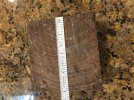Cushing H.
Gold Member
- Joined
- Jun 3, 2019
- Messages
- 2,714
I have searched the forum ... and did not quite find an answer for this - so here goes: I was at Woodcraft yesterday, and picked up a couple pieces of Ebony (1"x 1" x 8", waxed) that I hope to use as a component of Wa handles. I also picked up a block (larger, something like 3" x 6" x 6", waxed) of Verawood - both so inexpensive I could not resist the temptation. So, I thought I would build a small drying box and try my hand at drying and using these woods. One posting (another forum) said that Ebony will check, period, if the wax is removed. Most others say to remove the wax, except for the end grain, and allow to dry. so, am I destined for failure if I remove the wax (except said end grain) and drop these two pieces into a drying box - or might it work. If it does work, how long does said drying process typically take? (I know it is size dependent - I am considering taking that larger block of Verawood, cutting it down to smaller slabs then re-coating with wax)

